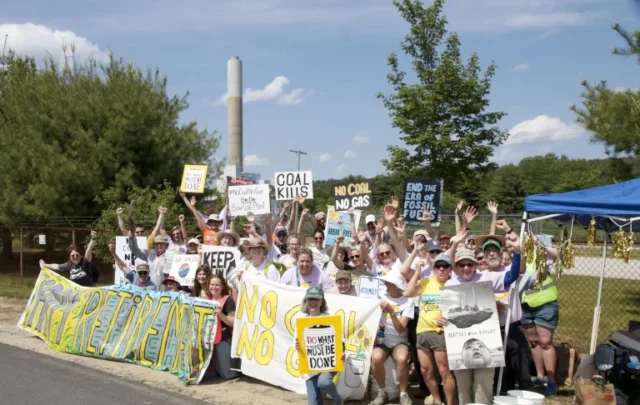NOTE: Images in this archived article have been removed.

Container terminal image via shutterstock. Reproduced at Resilience.org with permission.
The world needs to end its dependence on fossil fuels as quickly as possible. That’s the only sane response to climate change, and to the economic dilemma of declining oil, coal, and gas resource quality and increasing extraction costs. The nuclear industry is on life support in most countries, so the future appears to lie mostly with solar and wind power. But can we transition to these renewable energy sources and continue using energy the way we do today? And can we maintain our growth-based consumer economy?
The answer to both questions is, probably not. Let’s survey four important sectors of the energy economy and tally up the opportunities and challenges.
The electricity sector: Solar and wind produce electricity, and the fuel is free. Moreover, the cost of electricity from these sources is declining. These are encouraging trends. However, intermittency (the sun doesn’t always shine, the wind doesn’t always blow) still poses barriers to high levels of solar-wind electricity market share. Grid managers can easily integrate small variable inputs; but eventually storage, capacity redundancy, and major grid overhauls will be necessary to balance inputs with loads as higher proportions of electricity come from uncontrollable sources. All of this will be expensive—increasingly so as solar-wind market penetration levels exceed roughly 60 percent. Some of the problems associated with integrating variable renewables into the grid are being worked out over time. But even if all these problems are eventually resolved, only about one-fifth of all final energy is consumed in the form of electricity; how about other forms and ways in which we use energy—will they be easier or harder to transition?
The transport sector: Electric cars are becoming more common. But electric trucks and other heavy vehicles will pose more of a challenge due to the low energy density of battery storage (gasoline stores vastly more energy per kilogram). Ships could use kite sails, but that would only somewhat improve their fuel efficiency; otherwise there is no good replacement for oil in this key transport mode. The situation is similar, though even bleaker, for airplanes. Biofuels have been an energy fiasco, as the European Parliament has now admitted. And the construction of all of our vehicles, and the infrastructure they rely upon (including roads and runways), also depends upon industrial processes that currently require fossil fuels. That brings us to . . .
The industrial sector: Making pig iron—the main ingredient in steel—requires blast furnaces. Making cement requires 100-meter-long kilns that operate at 1500 degrees C. In principle it is possible to produce high heat for these purposes with electricity or giant solar collectors, but nobody does it that way now because it would be much more expensive than burning coal or natural gas. Crucially, current manufacturing processes for building solar panels and wind turbines also depend upon high-temperature industrial processes fueled by oil, coal, and natural gas. Again, alternative ways of producing this heat are feasible in principle—but the result would probably be significantly higher-cost solar and wind power. And there are no demonstration projects to show us just how easy or hard this would be.
The food sector: Nitrogen fertilizer is currently produced cheaply from natural gas; it could be made using solar or wind-sourced electricity, but that would again entail higher costs. Food products—and the chemical inputs to farming—are currently transported long distances using oil, and farm machinery runs on refined petroleum. It would be possible to grow food without chemical inputs and to re-localize food systems, but this would probably require more farm labor and might result in higher-priced food. Consumers would need to eat more seasonally and reduce their consumption of exotic foods.
In short, there are far more challenges associated with the energy transition than opportunities. There are potential solutions to all of the problems we have identified. But most of those solutions involve higher costs or reduced system functionality. Moreover, the energy dynamics of the transition itself will pose a challenge: where will the energy come from to build all the solar panels, wind turbines, batteries, electric blast furnaces, and solar cement kilns that we’ll need? Building the fossil-fueled energy producing-and-consuming infrastructure of the modern world has been by far the greatest construction project in human history. It took over a century, and it’s still a work in progress. Now we’ll have to replace most of this vast infrastructure with something different—different energy generators, different cars, trucks, roads, buildings, and industrial processes, using different materials (no petroleum-based plastics, no asphalt). All of this will take time, money . . . and energy.
And there’s the rub. Where will the energy come from? Realistically, most of it will have to come from fossil fuels—at least in the early-to-middle stages of the transition. And we’ll be using fossil fuels whose economic efficiency is declining due to the depletion of existing stocks of high-quality oil, gas, and coal. Again, this implies higher costs. Why not just use renewables to build renewables? Because it would be slower and even more expensive. Yet the faster we push the energy transition, the more energy will have to be diverted to that gargantuan project, and the less will be available to all the activities we’re already engaged in (running the transport, manufacturing, communications, and health care sectors, among others).
The issues surrounding the renewable energy transition are complicated and technical. And there are far too many of them to be fully addressed in a short article like this. But the preponderance of research literature supports the conclusion that the all-renewable industrial economy of the future will be less mobile and will produce fewer and more expensive goods. The 20th century industrial world was built on fossil fuels—and in some ways it was built for fossil fuels (as anyone who spends time in American suburban communities can attest). High mobility and the capacity for ever-expanding volumes of industrial production were hallmarks of that waning era. The latter decades of the current century will be shaped by entirely different energy sources, and society will be forced to change in profound ways.
That doesn’t have to be a bad thing. The globalized consumer society was always unsustainable anyway, and we might be happier without it. But unless we plan for the post-growth renewable future, existing economic institutions may tend to shatter rather than adapt smoothly.
The fossil fuel and nuclear industries have an understandable interest in disparaging renewable energy, but their days are numbered. We are headed toward a renewable future, whether we plan intelligently for it or not. Clearly, intelligent planning will offer the better path forward. One way to hasten the energy transition is simply to build more wind turbines and solar panels, as many climate scientists recommend.
But equally important to the transition will be our deliberate transformation of the ways we use energy. And that implies a nearly complete rethinking of the economy—both its means and its ends. Growth must no longer be the economy’s goal; rather, we must aim for the satisfaction of basic human needs within a shrinking budget of energy and materials. Meanwhile, to ensure the ongoing buy-in of the public in this vast collaborative project, our economic means must include the promotion of activities that increase human happiness and well being.







